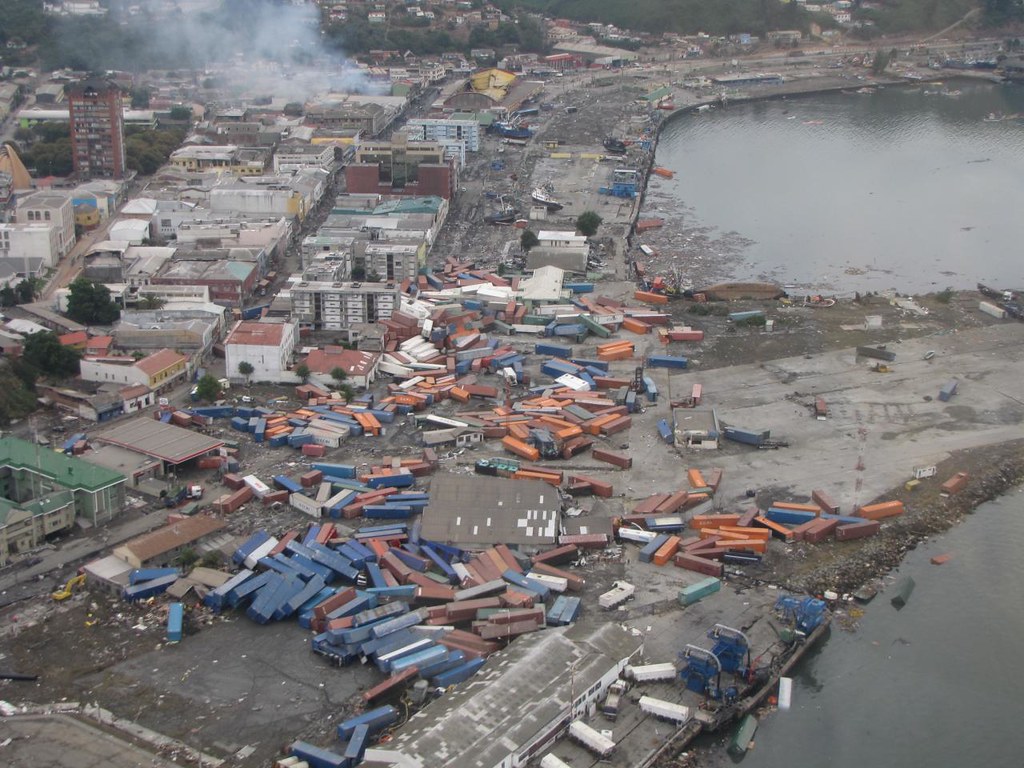
The aftermath of a 2010 tsunami in Chile, which was analyzed in a new study in JGR Solid Earth. Earlier warnings made possible by the study of tsunami-generated magnetic fields could better prepare coastal areas for impending disasters.
Credit: International Federation of Red Cross and Red Crescent Societies
A new study finds the magnetic field generated by a tsunami can be detected a few minutes earlier than changes in sea level and could improve warnings of these giant waves.
Tsunamis generate magnetic fields as they move conductive seawater through the Earth's magnetic field. Researchers previously predicted that the tsunami's magnetic field would arrive before a change in sea level, but they lacked simultaneous measurements of magnetics and sea level that are necessary to demonstrate the phenomenon.
The new study provides real-world evidence for using tsunamis' magnetic fields to predict the height of tsunami waves using data from two real events - a 2009 tsunami in Samoa and a 2010 tsunami in Chile - that have both sets of necessary data. The new study was published in AGU's Journal of Geophysical Research: Solid Earth, which focuses on the physics and chemistry of the solid Earth.
The study confirms the magnetic field generated by a tsunami arrives ahead of sea-level change and that its magnitude can be used to estimate the tsunami's wave height. How much earlier the magnetic field arrives depends on water depth, but in their results, the study authors found the early arrival time to be about one minute prior to sea level change over a 4,800-meter deep sea.
This information could provide earlier disaster warning if incorporated into tsunami risk models, potentially saving lives.
"It is very exciting because in previous studies we didn't have the observation [of] sea level change," said Zhiheng Lin, senior study author and a geophysicist at Kyoto University. "We have observations [of] sea level change, and we find that the observation agrees with our magnetic data as well as theoretical simulation."
The research team looked at simultaneous measurements of sea level change from seafloor pressure data and magnetic fields during the two tsunamis. They found that the primary arrival of the magnetic field, similar to that of the beginning of a seismic wave, can be used for the purpose of early tsunami warning. The tsunami-generated magnetic field is so sensitive that even a wave height of a few centimeters can be detected.
"They did something that basically needed to be done," said Neesha Schnepf, a researcher of geomagnetics at the University of Colorado, Boulder who was not involved in the study. "We've needed a study that compared the magnetic field data with the sea level change from the pressure data, and I'm pretty sure they're the first to really compare how well the sea level from magnetic field matches the sea level from pressure, so that's definitely very useful."
When the researchers compared the horizontal and vertical components of the tsunami magnetic field with sea level change, they found that both components can precisely predict tsunami sea level change, if models include good estimates for ocean depth and the electrical structure below the seafloor.
This relationship between magnetic fields and wave height can be used to improve tsunami source models, which estimate the initial sea surface topography of a tsunami and then predict water wave arrival time and wave height - important data for informing disaster readiness and response.
The difficulty of maintaining already limited observational stations means these types of data from tsunamis are often not available. Furthermore, these findings only apply in deep-sea and not coastal environments, where deep water in the region filters out environmental noise to allow the tsunami signal to be detected.
However, providing warning for these severe events - which have the potential to cause intense damage to large areas - makes the predictions worthwhile, said Lin.
"I think the practical goal would be if your ability to model tsunamis is so improved, … you could come up with much better predictions of what areas might need to be warned [and] how badly it might hit certain places," Schnepf said.






